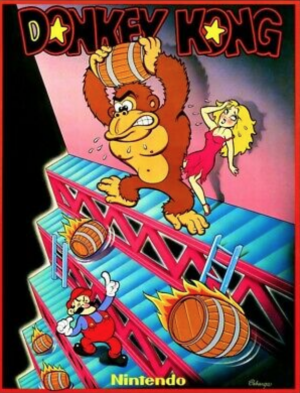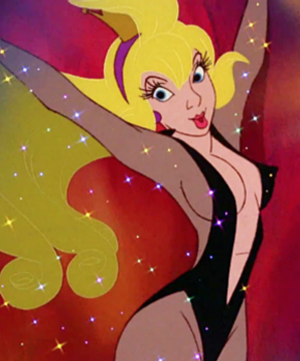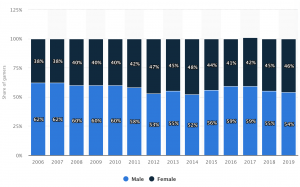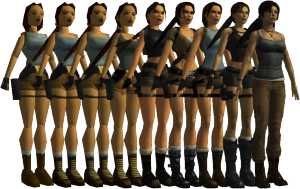Difference between revisions of "Gender in Video Games"
| (8 intermediate revisions by one other user not shown) | |||
| Line 1: | Line 1: | ||
| − | [[File:Screen Shot 2020-03-13 at 4.19.39 PM.png|thumbnail|Male and Female version of Sheperd, main character from the Mass Effect Series. 2007-2012]] | + | [[File:Screen Shot 2020-03-13 at 4.19.39 PM.png|thumbnail|Male and Female version of Sheperd, the main character from the Mass Effect Series. 2007-2012]] |
| − | Gender in video games refers to how gender identities are portrayed and represented in characters created for the video gaming medium. While gender is often tied to one's physical sex, the expression of gender itself is not inherently tied to any physical characteristics, and can correspond to or differ from physical sexual characteristics assigned at birth.<ref>“Understanding Gender.” Gender Spectrum, www.genderspectrum.org/quick-links/understanding-gender/.</ref> Gender ties more into one's self identity, as well as being a complex social construct that ties into the roles, behaviors, attributes and activities that | + | Gender in video games refers to how gender identities are portrayed and represented in characters created for the video gaming medium. While gender is often tied to one's physical sex, the expression of gender itself is not inherently tied to any physical characteristics, and can correspond to or differ from physical sexual characteristics assigned at birth.<ref>“Understanding Gender.” Gender Spectrum, www.genderspectrum.org/quick-links/understanding-gender/.</ref> Gender ties more into one's self-identity, as well as being a complex social construct that ties into the roles, behaviors, attributes, and activities that society finds appropriate for the male and female sexes. <ref>“Gender.” World Health Organization, World Health Organization, www.who.int/health-topics/gender.</ref> Despite the dichotomy of sexual characteristics in humans, gender can be expressed in a number of ways, which includes identities that do not strictly ascribe to the male and female sexes. Sexual Identity, which is sometimes misconstrued as gender identity alone, is actually a complex definition of its own, and while gender identity does play into one's sexual identity, they are not one in the same.<ref>“Student Counseling Center.” UT Dallas, www.utdallas.edu/counseling/sexualidentity/.</ref> A greater portion of games throughout history have focused on characters who identify along a more binary scale, and while this is is the prevailing accepted understanding of gender in society, even these portrayals have created controversy throughout the medium's history. |
==History== | ==History== | ||
| Line 6: | Line 6: | ||
The history of electronic gaming itself spans nearly 50 years when home consoles such as the Magnavox Odyssey were released back in the early 70's, yet the true heyday of gaming didn't start until the release of the Famicom in Japan, and the Nintendo Entertainment System (NES) to the US and the rest of the world in 1983. The trends that would define how gaming was seen for the foreseeable future, however, had already begun to emerge before the release of this system. | The history of electronic gaming itself spans nearly 50 years when home consoles such as the Magnavox Odyssey were released back in the early 70's, yet the true heyday of gaming didn't start until the release of the Famicom in Japan, and the Nintendo Entertainment System (NES) to the US and the rest of the world in 1983. The trends that would define how gaming was seen for the foreseeable future, however, had already begun to emerge before the release of this system. | ||
| − | In its early days, large cabinets were needed to produce the improved graphics desired by players over those of the home consoles, and arcades were the dominant place to socialize and enjoy these benefits. Since many gamers who would go to enjoy their pastime were much more often young adult men and boys than girls or women of comparable age, this affected the representation of gender in the games themselves since designers were not only looking to make a great game, they needed one that would appeal to the largest possible audience. As a pioneer of the medium and still active creator Shigeru Miyamoto states in an interview with Kotaku regarding the development of the 1981 game ''Donkey Kong'' : "back in the days when we made the first Donkey Kong, that was a game we first made for the arcades, the arcades were not places girls went into often. And so we didn't even consider making a character that would be playable for girls."<ref>Totilo, Stephen. “Shigeru Miyamoto and the Damsel In Distress.” Kotaku, 20 June 2013, 2:45, https://kotaku.com/shigeru-miyamoto-and-the-damsel-in-distress-520259897.</ref> This is likely the driving factor that | + | In its early days, large cabinets were needed to produce the improved graphics desired by players over those of the home consoles, and arcades were the dominant place to socialize and enjoy these benefits. Since many gamers who would go to enjoy their pastime were much more often young adult men and boys than girls or women of comparable age, this affected the representation of gender in the games themselves since designers were not only looking to make a great game, they needed one that would appeal to the largest possible audience. As a pioneer of the medium and still active creator Shigeru Miyamoto states in an interview with Kotaku regarding the development of the 1981 game ''Donkey Kong'' : "back in the days when we made the first Donkey Kong, that was a game we first made for the arcades, the arcades were not places girls went into often. And so we didn't even consider making a character that would be playable for girls."<ref>Totilo, Stephen. “Shigeru Miyamoto and the Damsel In Distress.” Kotaku, 20 June 2013, 2:45, https://kotaku.com/shigeru-miyamoto-and-the-damsel-in-distress-520259897.</ref> This is likely the driving factor that leads Nintendo to change the way that it marketed it's gaming consoles in the early 80's. |
| − | While gaming was originally a family activity for children and adults of all genders and ages alike<ref>Adam Ruins Everything - Why People Think Video Games Are Just for Boys. YouTube, uploaded by TruTV, 30 Nov. 2015, https://www.youtube.com/watch?v=i08CVkBxvBM</ref>, after the video game crash of 1983<ref>“Video Game Crash of 1983.” Wikipedia, Wikimedia Foundation, 18 Mar. 2020, en.wikipedia.org/wiki/Video_game_crash_of_1983</ref>, and due in large part to this understood discrepancy in male-to-female gamers at the time, Nintendo's new home console was marketed primarily toward boys and young men as a toy. Subsequent consoles of | + | While gaming was originally a family activity for children and adults of all genders and ages alike<ref>Adam Ruins Everything - Why People Think Video Games Are Just for Boys. YouTube, uploaded by TruTV, 30 Nov. 2015, https://www.youtube.com/watch?v=i08CVkBxvBM</ref>, after the video game crash of 1983<ref>“Video Game Crash of 1983.” Wikipedia, Wikimedia Foundation, 18 Mar. 2020, en.wikipedia.org/wiki/Video_game_crash_of_1983</ref>, and due in large part to this understood discrepancy in male-to-female gamers at the time, Nintendo's new home console was marketed primarily toward boys and young men as a toy. Subsequent consoles of that era followed suit and soon video gaming was seen as a hobby meant mostly for the male population. |
| Line 15: | Line 15: | ||
[[File:Duke-nukem.jpg|thumbnail|Duke Nukem. Self-titled series. 1991-2016]] | [[File:Duke-nukem.jpg|thumbnail|Duke Nukem. Self-titled series. 1991-2016]] | ||
[[File:Screen Shot 2020-03-29 at 12.12.16 PM.png|thumbnail|Princess Daphne from Dragon's Lair. 1983]] | [[File:Screen Shot 2020-03-29 at 12.12.16 PM.png|thumbnail|Princess Daphne from Dragon's Lair. 1983]] | ||
| − | + | Characters in games are often designed to be identifiable with the player in some fashion, whether this is through the expression of desired traits such as physical strength or fitness, or through the pursuit of a desired goal. Outside of the use of potentially addicting game mechanics, the ability for the player to place themselves in the shoes of the game's protagonist(s) and to share a desire to complete their goals and ambitions helps to keep the player engaged, and as such, they are more likely to continue playing the game. | |
| − | + | Trends in the late 80's and early 90's outside of gaming saw an increase in hyper-masculine content <ref>Kac-Vergne, Marianne. “Losing Visibility? The Rise and Fall of Hypermasculinity in Science...” InMedia. The French Journal of Media Studies, Institut Du Monde Anglophone, 15 Nov. 2012, journals.openedition.org/inmedia/491.</ref> which bled over into the gaming medium. While direct expressions of [https://en.wikipedia.org/wiki/Hypermasculinity hyper-masculinity]<ref>“Hypermasculinity.” Wikipedia, Wikimedia Foundation, 23 Feb. 2020, en.wikipedia.org/wiki/Hypermasculinity.</ref> were not always the focus, there existed games that were showcases for, if not a satire of, hyper-masculine traits, such as in games like Duke Nukem and Doom. These became predecessors to future games where masculine traits were also a focus such as God of War, Halo, and Grand Theft Auto. While not expressly advocating for violence or a lack of empathy toward women on their own, games in which women are sexualized and violence toward them is an option has shown in some studies to reduce empathy toward women in young adult men.<ref>Gabbiadini, Alessandro, et al. “Acting like a Tough Guy: Violent-Sexist Video Games, Identification with Game Characters, Masculine Beliefs, & Empathy for Female Violence Victims.” Plus One, vol. 11, no. 4, 2016, doi:10.1371/journal.pone.0152121.</ref>. | |
| − | + | However, just as the hyper-sexualization of men and male traits has been present in gaming, so too has, and to a greater extent, that of women and female traits as well. Because of the perceived lack of interest from female gamers, in many titles during this time women in gaming had played the role of the damsel in distress, wherein part the prize of a player winning the game was also to win the affection of a female love interest, such as Princess Peach of the Super Mario series, Marian from Double Dragon, or Princess Daphne from Dragon's Lair. In some of these games (such as the tertiary character and title of the previous list) the woman's physical traits and dress are designed in such a way that they enhance her socially perceived feminine attributes in the hopes of appealing further to the game's intended audience. By extension, the expression of female characteristics in this fashion outlines the character's physical characteristics as being more valuable assets to the player, rather than her ability to complete a task.<ref>Strum, Lora. “Study Tracks 31-Year History of Female Sexualization in Video Games.” PBS, Public Broadcasting Service, 8 July 2016, www.pbs.org/newshour/science/study-tracks-31-year-history-of-female-sexualization-in-video-games.</ref> | |
| − | + | In 1996, Core Design and Eidos Interactive's infamous title ''[https://en.wikipedia.org/wiki/Tomb_Raider_(1996_video_game) Tomb Raider]'' became an instant sensation. While the title's adventure-driven gameplay was originally planned to be headed by a male protagonist, worries from the designers that comparisons to Indiana Jones would potentially sink the title lead to the creation of a female lead in his stead. The puzzle-based gameplay was well-received on its own, however much attention was directed toward Lara Croft, the main character's physical characteristics and style of dress. Despite conquering bitter cold, sweltering jungles, wild animals, dinosaurs, and human enemies alike, Lara is outfitted for her inaugural adventure with a simple tank top and shorts, and despite being portrayed as a strong, independent, and more than capable woman with the ability to support herself, much attention was drawn to her physical traits. Despite this, claims by Eidos reveal that Lara's image was meant to remain acceptable for young adult audiences, and they even went as far as to go to court to keep her image out of Playboy.<ref>Romano, Aja. “Why We've Been Arguing about Lara Croft for Two Decades.” Vox, Vox, 17 Mar. 2018, www.vox.com/culture/2018/3/17/17128344/lara-croft-tomb-raider-history-controversy-breasts.</ref> The character and portrayal of Lara Croft have since become part of a decades-long discussion of women in gaming. | |
| − | + | ||
| − | The | + | |
==Overview of Player Base== | ==Overview of Player Base== | ||
[[File:Screen Shot 2020-03-13 at 4.41.12 PM.png|thumbnail|Distribution of male to female gamers from 2006-2019. Credit: Statistica.com]] | [[File:Screen Shot 2020-03-13 at 4.41.12 PM.png|thumbnail|Distribution of male to female gamers from 2006-2019. Credit: Statistica.com]] | ||
| − | A published medium has to take into account the audience who consumes their content, and the ways in which sex and gender have been expressed in video gaming has been due in no small part to said audience. While video gaming as a platform for published works is quite young in comparison to other popular forms of entertainment it takes many cues from such as comic books and film, and even in comparison to other forms of pop culture such as music, literature, and magazines, video gaming has a great impact on a large portion of the population today. In 2018, nearly 2.7 billion people worldwide played video games in some form, and individuals who identified as gamers accounted for 66% of the US population alone.<ref>Fuller, Steve. “U.S. Gamers.” www.statista.com, www.statista.com/topics/3070/us-gamers/</ref> While the medium has traditionally been seen as having a player base that largely identifies as male, today in the U.S. the difference is much closer to a 50/50 split<ref>Gough, Christina. “U.S. Video Gamer Gender Statistics 2019.” Statista, 3 July 2019, [http://www.statista.com/statistics/232383/gender-split-of-us-computer-and-video-gamers/ </ref>, as in 2019 it was reported that 46% of the population claiming to be part of the gaming community identified as female. This statistic, however, omits individuals who identify as non-binary. With the player base being so close to an even split today, and with continued pressure from third parties decrying the | + | A published medium has to take into account the audience who consumes their content, and the ways in which sex and gender have been expressed in video gaming has been due in no small part to said audience. While video gaming as a platform for published works is quite young in comparison to other popular forms of entertainment it takes many cues from such as comic books and film, and even in comparison to other forms of pop culture such as music, literature, and magazines, video gaming has a great impact on a large portion of the population today. In 2018, nearly 2.7 billion people worldwide played video games in some form, and individuals who identified as gamers accounted for 66% of the US population alone.<ref>Fuller, Steve. “U.S. Gamers.” www.statista.com, www.statista.com/topics/3070/us-gamers/</ref> While the medium has traditionally been seen as having a player base that largely identifies as male, today in the U.S. the difference is much closer to a 50/50 split<ref>Gough, Christina. “U.S. Video Gamer Gender Statistics 2019.” Statista, 3 July 2019, [http://www.statista.com/statistics/232383/gender-split-of-us-computer-and-video-gamers/ </ref>, as in 2019 it was reported that 46% of the population claiming to be part of the gaming community identified as female. This statistic, however, omits individuals who identify as non-binary. With the player base being so close to an even split today, and with continued pressure from third parties decrying the image of genders in gaming as they have been portrayed throughout history, the market has been slowly shifting. |
==Controversies== | ==Controversies== | ||
| − | [[File:Kindpng 1560760.png|thumbnail|Evolution of Lara Croft Character Model. Tomb Raider series. 1996-2013]] | + | [[File:Kindpng 1560760.png|thumbnail|Evolution of Lara Croft Character Model. Tomb Raider series. Images from 1996-2013]] |
| − | Throughout its many controversies, trials, and tribulations, the video gaming industry shows little sign of slowing down. In 2018 U.S. game sales reached $44.3 billion domestically, an increase of 18 percent over the previous year.<ref>“U.S. Video Game Sales Reach Record-Breaking $43.4 Billion in 2018.” Entertainment Software Association, 21 May 2019, www.theesa.com/press-releases/u-s-video-game-sales-reach-record-breaking-43-4-billion-in-2018/.</ref> Because of this there are | + | Throughout its many controversies, trials, and tribulations, the video gaming industry shows little sign of slowing down. In 2018 U.S. game sales reached $44.3 billion domestically, an increase of 18 percent over the previous year.<ref>“U.S. Video Game Sales Reach Record-Breaking $43.4 Billion in 2018.” Entertainment Software Association, 21 May 2019, www.theesa.com/press-releases/u-s-video-game-sales-reach-record-breaking-43-4-billion-in-2018/.</ref> Because of this there are more eyes on the industry now more than ever. Much of the controversy surrounding the expression of gender in gaming - especially that of women - took center stage in the mid-2010's after Anita Sarkeesian launched her Tropes vs. Women in Video Games YouTube series in 2013,<ref>“Tropes vs. Women in Video Games.” Wikipedia, Wikimedia Foundation, 4 Oct. 2019, en.wikipedia.org/wiki/Tropes_vs._Women_in_Video_Games.</ref><ref>Sarkeesian, Anita. “Tropes vs Women in Video Games - Season 1.” YouTube, Feminist Frequency, www.youtube.com/playlist?list=PLn4ob_5_ttEaA_vc8F3fjzE62esf9yP61.</ref> and again after the Gamergate Controversy in 2014. <ref>“Gamergate Controversy.” Wikipedia, Wikimedia Foundation, 27 Feb. 2020, en.wikipedia.org/wiki/Gamergate_controversy.</ref> While much of the gaming world took notice of these issues, it was ill-regarded by many in the community at large, yet game developers had already begun to take notice themselves, and changes to the Tomb Raider character Lara Croft, the very one who had been a central figure in female sexualization in gaming for decades, began to see a design change beginning in the very same decade; with her costume, figure, and character being reworked to represent a more conservative and practical perspective for the young adventuress. |
| + | |||
| + | |||
==Non-binary Genders in Gaming== | ==Non-binary Genders in Gaming== | ||
| − | While in the past the library of games exploring the concept of gender has been quite small, today a variety of titles exist that allow the player to play as, or see characters who express themselves and identify along the non-binary gender spectrum.<ref>“Steam Curator: LGBTQ+ Inclusive Gaming.” Steam Curator: LGBTQ+ Inclusive Gaming, store.steampowered.com/curator/11934326-LGBTQ-Inclusive-Gaming/list/488.</ref> Like with women in gaming throughout history, it is possible that these very games may one day be seen as possessing an antiquated view toward those who don't conform to the considered "gender norm," however the number of games in the past few years which allow players to simply explore the topic has seemingly increased exponentially, and that number continues to grow today. Studies and understanding of those who's relationship between sex and gender may be disconnected<ref>“What Is Gender Dysphoria?” What Is Gender Dysphoria?, Feb. 2016, www.psychiatry.org/patients-families/gender-dysphoria/what-is-gender-dysphoria.</ref> are still evolving, but the | + | While in the past the library of games exploring the concept of gender has been quite small, especially in that of what is considered "Triple A" releases, today a variety of titles exist that allow the player to play as, or see characters who express themselves and identify along the non-binary gender spectrum.<ref>“Steam Curator: LGBTQ+ Inclusive Gaming.” Steam Curator: LGBTQ+ Inclusive Gaming, store.steampowered.com/curator/11934326-LGBTQ-Inclusive-Gaming/list/488.</ref> Like with women in gaming throughout history, it is possible that these very games may one day be seen as possessing an antiquated view toward those who don't conform to the considered "gender norm," however the number of games in the past few years which allow players to simply explore the topic has seemingly increased exponentially, and that number continues to grow today. Studies and understanding of those who's relationship between sex and gender may be disconnected<ref>“What Is Gender Dysphoria?” What Is Gender Dysphoria?, Feb. 2016, www.psychiatry.org/patients-families/gender-dysphoria/what-is-gender-dysphoria.</ref> are still evolving, but the cultural reflection that gaming exhibits are continuing to bring issues of gender to light. |
==References== | ==References== | ||
[[Category:2020New]] | [[Category:2020New]] | ||
[[Category:2020Concept]] | [[Category:2020Concept]] | ||
Latest revision as of 16:11, 31 March 2020
Gender in video games refers to how gender identities are portrayed and represented in characters created for the video gaming medium. While gender is often tied to one's physical sex, the expression of gender itself is not inherently tied to any physical characteristics, and can correspond to or differ from physical sexual characteristics assigned at birth.[1] Gender ties more into one's self-identity, as well as being a complex social construct that ties into the roles, behaviors, attributes, and activities that society finds appropriate for the male and female sexes. [2] Despite the dichotomy of sexual characteristics in humans, gender can be expressed in a number of ways, which includes identities that do not strictly ascribe to the male and female sexes. Sexual Identity, which is sometimes misconstrued as gender identity alone, is actually a complex definition of its own, and while gender identity does play into one's sexual identity, they are not one in the same.[3] A greater portion of games throughout history have focused on characters who identify along a more binary scale, and while this is is the prevailing accepted understanding of gender in society, even these portrayals have created controversy throughout the medium's history.
Contents
History
The history of electronic gaming itself spans nearly 50 years when home consoles such as the Magnavox Odyssey were released back in the early 70's, yet the true heyday of gaming didn't start until the release of the Famicom in Japan, and the Nintendo Entertainment System (NES) to the US and the rest of the world in 1983. The trends that would define how gaming was seen for the foreseeable future, however, had already begun to emerge before the release of this system.
In its early days, large cabinets were needed to produce the improved graphics desired by players over those of the home consoles, and arcades were the dominant place to socialize and enjoy these benefits. Since many gamers who would go to enjoy their pastime were much more often young adult men and boys than girls or women of comparable age, this affected the representation of gender in the games themselves since designers were not only looking to make a great game, they needed one that would appeal to the largest possible audience. As a pioneer of the medium and still active creator Shigeru Miyamoto states in an interview with Kotaku regarding the development of the 1981 game Donkey Kong : "back in the days when we made the first Donkey Kong, that was a game we first made for the arcades, the arcades were not places girls went into often. And so we didn't even consider making a character that would be playable for girls."[4] This is likely the driving factor that leads Nintendo to change the way that it marketed it's gaming consoles in the early 80's.
While gaming was originally a family activity for children and adults of all genders and ages alike[5], after the video game crash of 1983[6], and due in large part to this understood discrepancy in male-to-female gamers at the time, Nintendo's new home console was marketed primarily toward boys and young men as a toy. Subsequent consoles of that era followed suit and soon video gaming was seen as a hobby meant mostly for the male population.
Expressions of Gender in Gaming
Characters in games are often designed to be identifiable with the player in some fashion, whether this is through the expression of desired traits such as physical strength or fitness, or through the pursuit of a desired goal. Outside of the use of potentially addicting game mechanics, the ability for the player to place themselves in the shoes of the game's protagonist(s) and to share a desire to complete their goals and ambitions helps to keep the player engaged, and as such, they are more likely to continue playing the game.
Trends in the late 80's and early 90's outside of gaming saw an increase in hyper-masculine content [7] which bled over into the gaming medium. While direct expressions of hyper-masculinity[8] were not always the focus, there existed games that were showcases for, if not a satire of, hyper-masculine traits, such as in games like Duke Nukem and Doom. These became predecessors to future games where masculine traits were also a focus such as God of War, Halo, and Grand Theft Auto. While not expressly advocating for violence or a lack of empathy toward women on their own, games in which women are sexualized and violence toward them is an option has shown in some studies to reduce empathy toward women in young adult men.[9].
However, just as the hyper-sexualization of men and male traits has been present in gaming, so too has, and to a greater extent, that of women and female traits as well. Because of the perceived lack of interest from female gamers, in many titles during this time women in gaming had played the role of the damsel in distress, wherein part the prize of a player winning the game was also to win the affection of a female love interest, such as Princess Peach of the Super Mario series, Marian from Double Dragon, or Princess Daphne from Dragon's Lair. In some of these games (such as the tertiary character and title of the previous list) the woman's physical traits and dress are designed in such a way that they enhance her socially perceived feminine attributes in the hopes of appealing further to the game's intended audience. By extension, the expression of female characteristics in this fashion outlines the character's physical characteristics as being more valuable assets to the player, rather than her ability to complete a task.[10]
In 1996, Core Design and Eidos Interactive's infamous title Tomb Raider became an instant sensation. While the title's adventure-driven gameplay was originally planned to be headed by a male protagonist, worries from the designers that comparisons to Indiana Jones would potentially sink the title lead to the creation of a female lead in his stead. The puzzle-based gameplay was well-received on its own, however much attention was directed toward Lara Croft, the main character's physical characteristics and style of dress. Despite conquering bitter cold, sweltering jungles, wild animals, dinosaurs, and human enemies alike, Lara is outfitted for her inaugural adventure with a simple tank top and shorts, and despite being portrayed as a strong, independent, and more than capable woman with the ability to support herself, much attention was drawn to her physical traits. Despite this, claims by Eidos reveal that Lara's image was meant to remain acceptable for young adult audiences, and they even went as far as to go to court to keep her image out of Playboy.[11] The character and portrayal of Lara Croft have since become part of a decades-long discussion of women in gaming.
Overview of Player Base
A published medium has to take into account the audience who consumes their content, and the ways in which sex and gender have been expressed in video gaming has been due in no small part to said audience. While video gaming as a platform for published works is quite young in comparison to other popular forms of entertainment it takes many cues from such as comic books and film, and even in comparison to other forms of pop culture such as music, literature, and magazines, video gaming has a great impact on a large portion of the population today. In 2018, nearly 2.7 billion people worldwide played video games in some form, and individuals who identified as gamers accounted for 66% of the US population alone.[12] While the medium has traditionally been seen as having a player base that largely identifies as male, today in the U.S. the difference is much closer to a 50/50 split[13], as in 2019 it was reported that 46% of the population claiming to be part of the gaming community identified as female. This statistic, however, omits individuals who identify as non-binary. With the player base being so close to an even split today, and with continued pressure from third parties decrying the image of genders in gaming as they have been portrayed throughout history, the market has been slowly shifting.
Controversies
Throughout its many controversies, trials, and tribulations, the video gaming industry shows little sign of slowing down. In 2018 U.S. game sales reached $44.3 billion domestically, an increase of 18 percent over the previous year.[14] Because of this there are more eyes on the industry now more than ever. Much of the controversy surrounding the expression of gender in gaming - especially that of women - took center stage in the mid-2010's after Anita Sarkeesian launched her Tropes vs. Women in Video Games YouTube series in 2013,[15][16] and again after the Gamergate Controversy in 2014. [17] While much of the gaming world took notice of these issues, it was ill-regarded by many in the community at large, yet game developers had already begun to take notice themselves, and changes to the Tomb Raider character Lara Croft, the very one who had been a central figure in female sexualization in gaming for decades, began to see a design change beginning in the very same decade; with her costume, figure, and character being reworked to represent a more conservative and practical perspective for the young adventuress.
Non-binary Genders in Gaming
While in the past the library of games exploring the concept of gender has been quite small, especially in that of what is considered "Triple A" releases, today a variety of titles exist that allow the player to play as, or see characters who express themselves and identify along the non-binary gender spectrum.[18] Like with women in gaming throughout history, it is possible that these very games may one day be seen as possessing an antiquated view toward those who don't conform to the considered "gender norm," however the number of games in the past few years which allow players to simply explore the topic has seemingly increased exponentially, and that number continues to grow today. Studies and understanding of those who's relationship between sex and gender may be disconnected[19] are still evolving, but the cultural reflection that gaming exhibits are continuing to bring issues of gender to light.
References
- ↑ “Understanding Gender.” Gender Spectrum, www.genderspectrum.org/quick-links/understanding-gender/.
- ↑ “Gender.” World Health Organization, World Health Organization, www.who.int/health-topics/gender.
- ↑ “Student Counseling Center.” UT Dallas, www.utdallas.edu/counseling/sexualidentity/.
- ↑ Totilo, Stephen. “Shigeru Miyamoto and the Damsel In Distress.” Kotaku, 20 June 2013, 2:45, https://kotaku.com/shigeru-miyamoto-and-the-damsel-in-distress-520259897.
- ↑ Adam Ruins Everything - Why People Think Video Games Are Just for Boys. YouTube, uploaded by TruTV, 30 Nov. 2015, https://www.youtube.com/watch?v=i08CVkBxvBM
- ↑ “Video Game Crash of 1983.” Wikipedia, Wikimedia Foundation, 18 Mar. 2020, en.wikipedia.org/wiki/Video_game_crash_of_1983
- ↑ Kac-Vergne, Marianne. “Losing Visibility? The Rise and Fall of Hypermasculinity in Science...” InMedia. The French Journal of Media Studies, Institut Du Monde Anglophone, 15 Nov. 2012, journals.openedition.org/inmedia/491.
- ↑ “Hypermasculinity.” Wikipedia, Wikimedia Foundation, 23 Feb. 2020, en.wikipedia.org/wiki/Hypermasculinity.
- ↑ Gabbiadini, Alessandro, et al. “Acting like a Tough Guy: Violent-Sexist Video Games, Identification with Game Characters, Masculine Beliefs, & Empathy for Female Violence Victims.” Plus One, vol. 11, no. 4, 2016, doi:10.1371/journal.pone.0152121.
- ↑ Strum, Lora. “Study Tracks 31-Year History of Female Sexualization in Video Games.” PBS, Public Broadcasting Service, 8 July 2016, www.pbs.org/newshour/science/study-tracks-31-year-history-of-female-sexualization-in-video-games.
- ↑ Romano, Aja. “Why We've Been Arguing about Lara Croft for Two Decades.” Vox, Vox, 17 Mar. 2018, www.vox.com/culture/2018/3/17/17128344/lara-croft-tomb-raider-history-controversy-breasts.
- ↑ Fuller, Steve. “U.S. Gamers.” www.statista.com, www.statista.com/topics/3070/us-gamers/
- ↑ Gough, Christina. “U.S. Video Gamer Gender Statistics 2019.” Statista, 3 July 2019, [http://www.statista.com/statistics/232383/gender-split-of-us-computer-and-video-gamers/
- ↑ “U.S. Video Game Sales Reach Record-Breaking $43.4 Billion in 2018.” Entertainment Software Association, 21 May 2019, www.theesa.com/press-releases/u-s-video-game-sales-reach-record-breaking-43-4-billion-in-2018/.
- ↑ “Tropes vs. Women in Video Games.” Wikipedia, Wikimedia Foundation, 4 Oct. 2019, en.wikipedia.org/wiki/Tropes_vs._Women_in_Video_Games.
- ↑ Sarkeesian, Anita. “Tropes vs Women in Video Games - Season 1.” YouTube, Feminist Frequency, www.youtube.com/playlist?list=PLn4ob_5_ttEaA_vc8F3fjzE62esf9yP61.
- ↑ “Gamergate Controversy.” Wikipedia, Wikimedia Foundation, 27 Feb. 2020, en.wikipedia.org/wiki/Gamergate_controversy.
- ↑ “Steam Curator: LGBTQ+ Inclusive Gaming.” Steam Curator: LGBTQ+ Inclusive Gaming, store.steampowered.com/curator/11934326-LGBTQ-Inclusive-Gaming/list/488.
- ↑ “What Is Gender Dysphoria?” What Is Gender Dysphoria?, Feb. 2016, www.psychiatry.org/patients-families/gender-dysphoria/what-is-gender-dysphoria.





